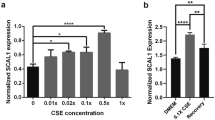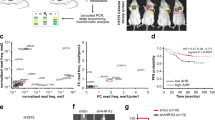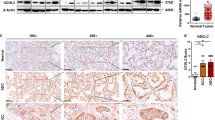Abstract
Aryl hydrocarbon receptor (AhR) is a ligand-activated transcription factor that is activated by cigarette smoke. Previously, we demonstrated that AhR is overexpressed in lung adenocarcinomas (ADs). In this study we observed that AhR expression is significantly correlated with nuclear RelA (a nuclear factor-κB (NFκB) subunit) and cytosolic interleukin-6 (IL-6) in 200 non-small cell lung cancer patients, especially among never smokers. Overexpression of AhR increased IL-6 expression in H1355 cells and immortalized human bronchial epithelial cells BEAS-2B. As NFκB inhibitor and knockdown RelA expression greatly reduced constitutive AhR-induced IL-6 expression, we hypothesized that AhR expression, in the absence of exogenous ligand, is able to modulate NFκB activity and subsequently upregulate IL-6 expression, thus promoting the development of lung AD. Specifically, AhR overexpression significantly increased NFκB activity, whereas interference with AhR expression significantly reduced NFκB activity and IL-6 expression in H1355 cells. We demonstrated that AhR associates with RelA in the cytosol and nucleus of human lung cells. Furthermore, AhR overexpression enhanced nuclear localization of AhR and RelA, and increased the association of AhR–RelA with the NFκB response element of the IL-6 promoter. However, p50 was not involved. Our results indicate that AhR, without exposure to a ligand, associates with RelA, which then positively modulates NFκB activity and then upregulates IL-6 expression in human lung cells. Thus we have identified a new mechanism for lung tumorigenesis in non-smokers.
This is a preview of subscription content, access via your institution
Access options
Subscribe to this journal
Receive 50 print issues and online access
$259.00 per year
only $5.18 per issue
Buy this article
- Purchase on Springer Link
- Instant access to full article PDF
Prices may be subject to local taxes which are calculated during checkout







Similar content being viewed by others
References
Aggarwal BB . (2004). Nuclear factor-kappaB: the enemy within. Cancer Cell 6: 203–208.
Ando M, Wakai K, Seki N, Tamakoshi A, Suzuki K, Ito Y et al. (2003). Attributable and absolute risk of lung cancer death by smoking status: findings from the Japan Collaborative Cohort Study. Int J Cancer 105: 249–254.
Arenzana-Seisdedos F, Turpin P, Rodriguez M, Thomas D, Hay RT, Virelizier JL et al. (1997). Nuclear localization of I kappa B alpha promotes active transport of NF-kappa B from the nucleus to the cytoplasm. J Cell Sci 110 (Part 3): 369–378.
Barouki R, Coumoul X, Fernandez-Salguero PM . (2007). The aryl hydrocarbon receptor, more than a xenobiotic-interacting protein. FEBS Lett 581: 3608–3615.
Bryant A, Cerfolio RJ . (2007). Differences in epidemiology, histology, and survival between cigarette smokers and never-smokers who develop non-small cell lung cancer. Chest 132: 185–192.
Camacho IA, Singh N, Hegde VL, Nagarkatti M, Nagarkatti PS . (2005). Treatment of mice with 2,3,7,8-tetrachlorodibenzo-p-dioxin leads to aryl hydrocarbon receptor-dependent nuclear translocation of NF-kappaB and expression of Fas ligand in thymic stromal cells and consequent apoptosis in T cells. J Immunol 175: 90–103.
Carolan BJ, Harvey BG, De BP, Vanni H, Crystal RG . (2008). Decreased expression of intelectin 1 in the human airway epithelium of smokers compared to nonsmokers. J Immunol 181: 5760–5767.
Chang JT, Chang H, Chen PH, Lin SL, Lin P . (2007a). Requirement of aryl hydrocarbon receptor overexpression for CYP1B1 up-regulation and cell growth in human lung adenocarcinomas. Clin Cancer Res 13: 38–45.
Chang LW, Chang YC, Ho CC, Tsai MH, Lin P . (2007b). Increase of carcinogenic risk via enhancement of cyclooxygenase-2 expression and hydroxyestradiol accumulation in human lung cells as a result of interaction between BaP and 17-beta estradiol. Carcinogenesis 28: 1606–1612.
Chen CL, Hsu LI, Chiou HY, Hsueh YM, Chen SY, Wu MM et al. (2004a). Ingested arsenic, cigarette smoking, and lung cancer risk: a follow-up study in arseniasis-endemic areas in Taiwan. JAMA 292: 2984–2990.
Chen J, Yan Y, Li J, Ma Q, Stoner GD, Ye J et al. (2005). Differential requirement of signal pathways for benzo[a]pyrene (B[a]P)-induced nitric oxide synthase (iNOS) in rat esophageal epithelial cells. Carcinogenesis 26: 1035–1043.
Chen L, Fischle W, Verdin E, Greene WC . (2001). Duration of nuclear NF-kappaB action regulated by reversible acetylation. Science 293: 1653–1657.
Chen YC, Chen JH, Richard K, Chen PY, Christiani DC . (2004b). Lung adenocarcinoma and human papillomavirus infection. Cancer 101: 1428–1436.
Dalwadi H, Krysan K, Heuze-Vourc'h N, Dohadwala M, Elashoff D, Sharma S et al. (2005). Cyclooxygenase-2-dependent activation of signal transducer and activator of transcription 3 by interleukin-6 in non-small cell lung cancer. Clin Cancer Res 11: 7674–7682.
Denison MS, Nagy SR . (2003). Activation of the aryl hydrocarbon receptor by structurally diverse exogenous and endogenous chemicals. Annu Rev Pharmacol Toxicol 43: 309–334.
Devesa SS, Bray F, Vizcaino AP, Parkin DM . (2005). International lung cancer trends by histologic type: male:female differences diminishing and adenocarcinoma rates rising. Int J Cancer 117: 294–299.
Dhar A, Young MR, Colburn NH . (2002). The role of AP-1, NF-kappaB and ROS/NOS in skin carcinogenesis: the JB6 model is predictive. Mol Cell Biochem 234–235: 185–193.
Dietrich C, Kaina B . (2010). The aryl hydrocarbon receptor (AhR) in the regulation of cell-cell contact and tumor growth. Carcinogenesis 31: 1319–1328.
Dijsselbloem N, Vanden Berghe W, De Naeyer A, Haegeman G . (2004). Soy isoflavone phyto-pharmaceuticals in interleukin-6 affections. Multi-purpose nutraceuticals at the crossroad of hormone replacement, anti-cancer and anti-inflammatory therapy. Biochem Pharmacol 68: 1171–1185.
DiNatale BC, Schroeder JC, Francey LJ, Kusnadi A, Perdew GH . (2010). Mechanistic insights into the events that lead to synergistic induction of interleukin 6 transcription upon activation of the aryl hydrocarbon receptor and inflammatory signaling. J Biol Chem 285: 24388–24397.
Fukuda I, Mukai R, Kawase M, Yoshida K, Ashida H . (2007). Interaction between the aryl hydrocarbon receptor and its antagonists, flavonoids. Biochem Biophys Res Commun 359: 822–827.
Gao SG, Dong XY, Wang LJ, He J . (2007). The study on the chromosome aneuploidy in human lung cancer]. Zhonghua Yi Xue Za Zhi 87: 1701–1703.
Hayashibara T, Yamada Y, Mori N, Harasawa H, Sugahara K, Miyanishi T et al. (2003). Possible involvement of aryl hydrocarbon receptor (AhR) in adult T-cell leukemia (ATL) leukemogenesis: constitutive activation of AhR in ATL. Biochem Biophys Res Commun 300: 128–134.
Ishida M, Mikami S, Kikuchi E, Kosaka T, Miyajima A, Nakagawa K et al. (2010). Activation of the aryl hydrocarbon receptor pathway enhances cancer cell invasion by upregulating the MMP expression and is associated with poor prognosis in upper urinary tract urothelial cancer. Carcinogenesis 31: 287–295.
Izawa H, Kohara M, Aizawa K, Suganuma H, Inakuma T, Watanabe G et al. (2008). Alleviative effects of quercetin and onion on male reproductive toxicity induced by diesel exhaust particles. Biosci Biotechnol Biochem 72: 1235–1241.
Jensen BA, Leeman RJ, Schlezinger JJ, Sherr DH . (2003). Aryl hydrocarbon receptor (AhR) agonists suppress interleukin-6 expression by bone marrow stromal cells: an immunotoxicology study. Environ Health 2: 16.
Kasai A, Hiramatsu N, Hayakawa K, Yao J, Maeda S, Kitamura M . (2006). High levels of dioxin-like potential in cigarette smoke evidenced by in vitro and in vivo biosensing. Cancer Res 66: 7143–7150.
Ke S, Rabson AB, Germino JF, Gallo MA, Tian Y . (2001). Mechanism of suppression of cytochrome P-450 1A1 expression by tumor necrosis factor-alpha and lipopolysaccharide. J Biol Chem 276: 39638–39644.
Kim DW, Gazourian L, Quadri SA, Romieu-Mourez R, Sherr DH, Sonenshein GE . (2000). The RelA NF-kappaB subunit and the aryl hydrocarbon receptor (AhR) cooperate to transactivate the c-myc promoter in mammary cells. Oncogene 19: 5498–5506.
Liaw YP, Huang YC, Lien GW . (2005). Patterns of lung cancer mortality in 23 countries: application of the age-period-cohort model. BMC Public Health 5: 22.
Lin P, Chang H, Tsai WT, Wu MH, Liao YS, Chen JT et al. (2003). Overexpression of aryl hydrocarbon receptor in human lung carcinomas. Toxicol Pathol 31: 22–30.
Lin PH, Lin CH, Huang CC, Chuang MC, Lin P . (2007). 2,3,7,8-Tetrachlorodibenzo-p-dioxin (TCDD) induces oxidative stress, DNA strand breaks, and poly(ADP-ribose) polymerase-1 activation in human breast carcinoma cell lines. Toxicol Lett 172: 146–158.
Lu F, Zahid M, Wang C, Saeed M, Cavalieri EL, Rogan EG . (2008). Resveratrol prevents estrogen-DNA adduct formation and neoplastic transformation in MCF-10F cells. Cancer Prev Res (Phila) 1: 135–145.
Matsumoto Y, Ide F, Kishi R, Akutagawa T, Sakai S, Nakamura M et al. (2007). Aryl hydrocarbon receptor plays a significant role in mediating airborne particulate-induced carcinogenesis in mice. Environ Sci Technol 41: 3775–3780.
Mukai M, Tischkau SA . (2007). Effects of tryptophan photoproducts in the circadian timing system: searching for a physiological role for aryl hydrocarbon receptor. Toxicol Sci 95: 172–181.
Oesch-Bartlomowicz B, Huelster A, Wiss O, Antoniou-Lipfert P, Dietrich C, Arand M et al. (2005). Aryl hydrocarbon receptor activation by cAMP vs dioxin: divergent signaling pathways. Proc Natl Acad Sci USA 102: 9218–9223.
Ohtake F, Baba A, Takada I, Okada M, Iwasaki K, Miki H et al. (2007). Dioxin receptor is a ligand-dependent E3 ubiquitin ligase. Nature 446: 562–566.
Peng TL, Chen J, Mao W, Song X, Chen MH . (2009). Aryl hydrocarbon receptor pathway activation enhances gastric cancer cell invasiveness likely through a c-Jun-dependent induction of matrix metalloproteinase-9. BMC Cell Biol 10: 27.
Pollenz RS . (2002). The mechanism of AH receptor protein down-regulation (degradation) and its impact on AH receptor-mediated gene regulation. Chem Biol Interact 141: 41–61.
Puga A, Barnes SJ, Chang C, Zhu H, Nephew KP, Khan SA et al. (2000). Activation of transcription factors activator protein-1 and nuclear factor-kappaB by 2,3,7,8-tetrachlorodibenzo-p-dioxin. Biochem Pharmacol 59: 997–1005.
Scagliotti GV, Longo M, Novello S . (2009). Nonsmall cell lung cancer in never smokers. Curr Opin Oncol 21: 99–104.
Sharma D, Fondell JD . (2002). Ordered recruitment of histone acetyltransferases and the TRAP/Mediator complex to thyroid hormone-responsive promoters in vivo. Proc Natl Acad Sci USA 99: 7934–7939.
Shimba S, Komiyama K, Moro I, Tezuka M . (2002). Overexpression of the aryl hydrocarbon receptor (AhR) accelerates the cell proliferation of A549 cells. J Biochem 132: 795–802.
Smith PC, Hobisch A, Lin DL, Culig Z, Keller ET . (2001). Interleukin-6 and prostate cancer progression. Cytokine Growth Factor Rev 12: 33–40.
Su JM, Lin P, Wang CK, Chang H . (2009). Overexpression of cytochrome P450 1B1 in advanced non-small cell lung cancer: a potential therapeutic target. Anticancer Res 29: 509–515.
Subramanian J, Velcheti V, Gao F, Govindan R . (2007). Presentation and stage-specific outcomes of lifelong never-smokers with non-small cell lung cancer (NSCLC). J Thorac Oncol 2: 827–830.
Tan XL, Wang T, Xiong S, Kumar SV, Han W, Spivack SD . (2009). Smoking-related gene expression in laser capture-microdissected human lung. Clin Cancer Res 15: 7562–7570.
Thun MJ, Hannan LM, Adams-Campbell LL, Boffetta P, Buring JE, Feskanich D et al. (2008). Lung cancer occurrence in never-smokers: an analysis of 13 cohorts and 22 cancer registry studies. PLoS Med 5: e185.
Tian Y . (2009). Ah receptor and NF-kappaB interplay on the stage of epigenome. Biochem Pharmacol 77: 670–680.
Trikha M, Corringham R, Klein B, Rossi JF . (2003). Targeted anti-interleukin-6 monoclonal antibody therapy for cancer: a review of the rationale and clinical evidence. Clin Cancer Res 9: 4653–4665.
Tse LA, Yu IT, Au JS, Yu KS, Kwok KP, Qiu H et al. (2009). Environmental tobacco smoke and lung cancer among Chinese nonsmoking males: might adenocarcinoma be the culprit? Am J Epidemiol 169: 533–541.
Vanden Berghe W, Dijsselbloem N, Vermeulen L, Ndlovu N, Boone E, Haegeman G . (2006). Attenuation of mitogen- and stress-activated protein kinase-1-driven nuclear factor-kappaB gene expression by soy isoflavones does not require estrogenic activity. Cancer Res 66: 4852–4862.
Wang CK, Chang H, Chen PH, Chang JT, Kuo YC, Ko JL et al. (2009a). Aryl hydrocarbon receptor activation and overexpression upregulated fibroblast growth factor-9 in human lung adenocarcinomas. Int J Cancer 125: 807–815.
Wang XR, Yu IT, Chiu YL, Qiu H, Fu Z, Goggins W et al. (2009b). Previous pulmonary disease and family cancer history increase the risk of lung cancer among Hong Kong women. Cancer Causes Control 20: 757–763.
Whitlock Jr JP . (1999). Induction of cytochrome P4501A1. Annu Rev Pharmacol Toxicol 39: 103–125.
Yu IT, Chiu YL, Au JS, Wong TW, Tang JL . (2006). Dose-response relationship between cooking fumes exposures and lung cancer among Chinese nonsmoking women. Cancer Res 66: 4961–4967.
Zerbini LF, Wang Y, Cho JY, Libermann TA . (2003). Constitutive activation of nuclear factor kappaB p50/p65 and Fra-1 and JunD is essential for deregulated interleukin 6 expression in prostate cancer. Cancer Res 63: 2206–2215.
Acknowledgements
This work was supported by grants from the National Health Research Institutes (99A1-EOPP02-014) and the National Science Council (NSC 97-2320-B-040-016 and NSC 97-2314-B-400-010) of Taiwan.
Author information
Authors and Affiliations
Corresponding authors
Ethics declarations
Competing interests
The authors declare no conflict of interest.
Rights and permissions
About this article
Cite this article
Chen, PH., Chang, H., Chang, J. et al. Aryl hydrocarbon receptor in association with RelA modulates IL-6 expression in non-smoking lung cancer. Oncogene 31, 2555–2565 (2012). https://doi.org/10.1038/onc.2011.438
Received:
Revised:
Accepted:
Published:
Issue Date:
DOI: https://doi.org/10.1038/onc.2011.438
Keywords
This article is cited by
-
Implications of xenobiotic-response element(s) and aryl hydrocarbon receptor in health and diseases
Human Cell (2023)
-
Particulate matter promotes cancer metastasis through increased HBEGF expression in macrophages
Experimental & Molecular Medicine (2022)
-
Lead Nitrate Induces Inflammation and Apoptosis in Rat Lungs Through the Activation of NF-κB and AhR Signaling Pathways
Environmental Science and Pollution Research (2022)
-
The emerging role of aryl hydrocarbon receptor in the activation and differentiation of Th17 cells
Cellular and Molecular Life Sciences (2016)
-
AhR and Arnt differentially regulate NF-κB signaling and chemokine responses in human bronchial epithelial cells
Cell Communication and Signaling (2014)



